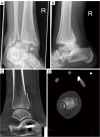Treatment strategies for complex ankle fractures-current developments summarized in a narrative review
- PMID: 37970612
- PMCID: PMC10632576
- DOI: 10.21037/atm-23-1173
Treatment strategies for complex ankle fractures-current developments summarized in a narrative review
Abstract
Background and objective: Ankle fractures occur frequently in patients throughout all ages. Due to the many pitfalls associated with their treatment, complex ankle and especially tibial pilon fractures remain a challenge for surgeons. As there is still need for improvement in treating complex ankle fractures and treatment options are steadily increasing this review aims to summarize current practice and aims to highlight current developments by reviewing the literature.
Methods: We conducted a thorough search of PubMed database in December 2022 to identify relevant articles on complex ankle and tibial pilon fractures. Articles in English and German were included in this study.
Key contents and findings: Complication rates, especially wound infection are still high, emphasizing the need for careful preoperative planning. Soft tissue management is crucial to reduce complication rates and will often dictate the treatment plan utilized. Open reduction and internal fixation (ORIF) remains the treatment of choice. Nevertheless, in select cases alternative methods such as external fixation, tibiotalocalcaneal nailing or conservative treatment need to be considered as well. Furthermore, additional treatment options such as arthroscopically assisted surgery might help to improve functional outcome after complex ankle fractures. The incidence of complex ankle fractures in geriatric patients keeps rising with our aging population. This group of patients demands particular care and further high-quality studies are needed to warrant best results.
Conclusions: However, more randomized controlled trials are need in order to enhance evidence of newly developed treatment options.
Keywords: Complex ankle fractures; osteosynthesis; soft tissue management.
2023 Annals of Translational Medicine. All rights reserved.
Conflict of interest statement
Conflicts of Interest: All authors have completed the ICMJE uniform disclosure form (available at https://atm.amegroups.com/article/view/10.21037/atm-23-1173/coif). The series “Foot and Ankle Surgery” was commissioned by the editorial office without any funding or sponsorship. The authors have no other conflicts of interest to declare.
Figures







Similar articles
-
Distal tibial pilon fractures (AO/OTA type B, and C) treated with the external skeletal and minimal internal fixation method.Vojnosanit Pregl. 2013 Sep;70(9):836-41. doi: 10.2298/vsp1309836m. Vojnosanit Pregl. 2013. PMID: 24266311
-
Comparison of complications and reoperations in AO/OTA 43.C3 pilon fractures treated with conventional ORIF versus minimally invasive hexapod ring fixation.Injury. 2023 Nov;54 Suppl 6:110884. doi: 10.1016/j.injury.2023.110884. Injury. 2023. PMID: 38143151
-
A staged protocol for soft tissue management in the treatment of complex pilon fractures.J Orthop Trauma. 2004 Sep;18(8 Suppl):S32-8. doi: 10.1097/00005131-200409001-00005. J Orthop Trauma. 2004. PMID: 15472563
-
Arthroscopically Assisted Internal Fixation of Foot and Ankle Fractures: A Systematic Review.Foot Ankle Orthop. 2021 Jan 21;6(1):2473011420950214. doi: 10.1177/2473011420950214. eCollection 2021 Jan. Foot Ankle Orthop. 2021. PMID: 35097419 Free PMC article. Review.
-
Locked intramedullary nailing provides superior functional outcomes and lower complication rates than plate fixation of distal fibula fractures. A systematic review and meta-analysis of comparative studies.Foot Ankle Surg. 2022 Oct;28(7):986-994. doi: 10.1016/j.fas.2022.02.005. Epub 2022 Feb 12. Foot Ankle Surg. 2022. PMID: 35184992
Cited by
-
Orthoplastic Reconstruction of Distal Tibia High-Energy Fractures Using a Circular External Fixator-A Systematic Review.J Clin Med. 2024 Sep 25;13(19):5700. doi: 10.3390/jcm13195700. J Clin Med. 2024. PMID: 39407767 Free PMC article. Review.
-
Foot and ankle surgery: new frontiers for translational advancements.Ann Transl Med. 2024 Jun 10;12(3):42. doi: 10.21037/atm-2023-28. Epub 2024 Jan 10. Ann Transl Med. 2024. PMID: 38911565 Free PMC article. No abstract available.
-
Case Report: A severe case of traumatic ankle fracture-dislocation with medial malleolar bony defect and 5-year follow-up.Front Surg. 2025 Apr 14;12:1553498. doi: 10.3389/fsurg.2025.1553498. eCollection 2025. Front Surg. 2025. PMID: 40297645 Free PMC article.
-
Functional and Radiological Outcomes of Medial Malleolus Fracture Fixation Using Headless Compression Screws.Cureus. 2025 May 10;17(5):e83869. doi: 10.7759/cureus.83869. eCollection 2025 May. Cureus. 2025. PMID: 40502876 Free PMC article.
References
-
- Mauffrey C, Vasario G, Battiston B, et al. Tibial pilon fractures: a review of incidence, diagnosis, treatment, and complications. Acta Orthop Belg 2011;77:432-40. - PubMed
Publication types
LinkOut - more resources
Full Text Sources
Research Materials
